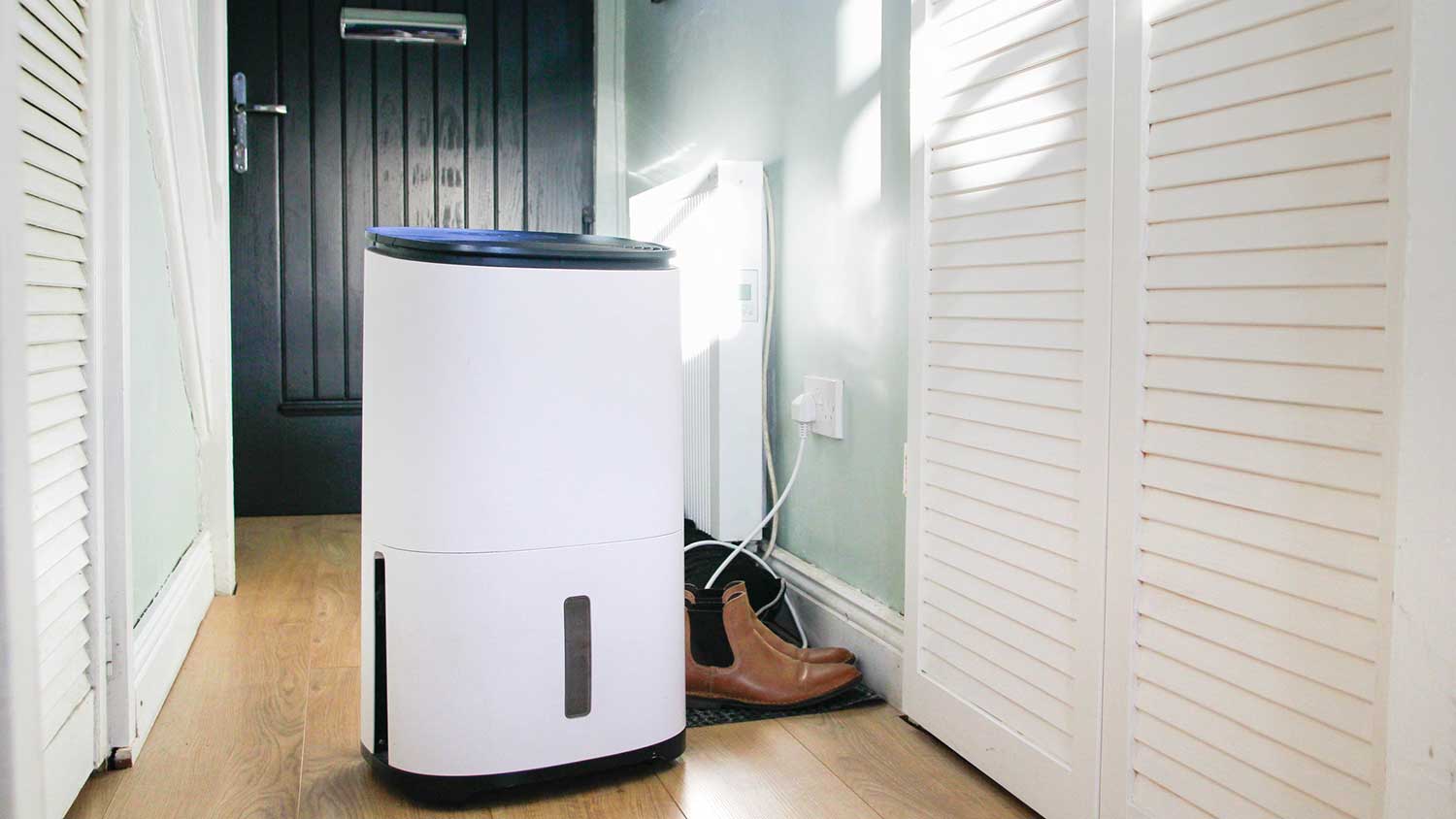How to Clean Your AC So It Runs All Summer Long
Our hot tips for a cool summer
If you’ve ever wondered how to clean AC units, you’ve come to the right place. Warm weather means your air conditioner is ready to come out of hibernation, but what about all that dust and grime that set up camp inside it over the winter? Getting your AC serviced by an HVAC professional in the spring is always wise, but you may be able to do some cleaning yourself.
1. Cut the Power
Start by turning off your air conditioning unit. Cleaning a standard HVAC system while it’s running is dangerous—both for you and your air conditioner. There’s usually a shut-off box somewhere near the condenser unit (the portion of the AC system located outside your home). Unless you know what you’re doing, it’s best to switch off the main breaker. Use a flashlight or other light source to get a good look.
2. Clean Debris From the Outdoor Condenser Unit
Outdoor condensers can collect all kinds of debris, from grass clippings to decaying leaves. Peer into the protective grille around your unit and look for debris in the fan (at the top of the unit) and fins (around the unit). Use a garden hose to rinse away the debris or remove it with your hands. You can scrub dirt on the protective grille with a cloth and soapy water. Do not get the electrical box wet under any circumstances.
3. Clean the Condenser Coils
There are two types of air conditioner coils that need cleaning: the condenser coils and the evaporator coils. If rinsing wasn’t enough to remove stubborn debris, clean the condenser coils and fins by hand. Remove the protective grille (or side panels) around your unit using a screwdriver.
Then, do the following:
Gently brush the AC coils and fins using a soft brush.
Cover electrical components with a plastic bag to protect them from moisture.
Spray no-rinse coil cleaner on the condenser coils.
Use a hose to spray off the cleaner after a few minutes (optional).
Make sure electrical components don’t come into contact with coil cleaner or water. Be careful not to touch the coil cleaner with bare hands since it can cause irritation.
4. Straighten the Fins and Cover Your Condenser
If any fins bend out of shape during the cleaning process, brush them with a fin comb to straighten them out. Put the protective cover back on your AC, and head inside to clean the rest of your HVAC system.
5. Change the Air Conditioner Filter

The more you run your system, the more dirt and debris will clog up your filter. Change your air conditioner filter at least every three months. Since dirty air ducts will muck up the cleanest air conditioning units, hire a local air duct cleaner if you notice any signs of dirty ducts, including:
A need to change your filter more frequently
Debris built up along your air vents
6. Clean the Evaporator Coils
Evaporator coils are located on the indoor portion of your AC system. In a standard HVAC unit, they’re usually in a box attached to the furnace or inside your air conditioner air handler. You can reach the coils through an access panel, which opens using a knob or by unscrewing screws. Once you open the panel:
Remove dust from the coil with a soft brush.
Spray coil cleaner evenly on the evaporator coils.
Remove any remaining grime with a soft brush (optional).
7. Clean the AC Drain Pan
If your coil cleaner is working, it should be dripping into your air conditioner’s drain pan, taking the dust and grime with it. This means you’ll also need to clean your drain pan. Use a soapy solution and wipe the drain pan down with a cloth. If the pan isn’t draining normally, you may need to call in a professional to remove a clog.
8. Close the Access Panel and Give Your AC a Test Run

When you’re done cleaning your unit, close the access panel. Make sure your AC unit has fully dried before turning on the power. If you cleaned your AC unit because of a problem—like poor performance or a weird smell—give it a test run. If the problem persists, consider hiring a local HVAC repair specialist.
Cleaning Your Window AC Unit
Even if you have a window AC unit, you should clean it at least once per year to ensure its efficiency. But the process is a little different—and usually faster—than cleaning central AC systems.
1. Turn Off the AC Unit
Before you get started, make sure to turn off your AC unit to avoid any potential hazards. Start by turning off the unit using the power switch or button, then unplug it from the wall. If the unit is warm to the touch, wait a few minutes for it to cool down before proceeding to the next step.
2. Remove and Clean the Front Cover
The front cover of an AC unit tends to collect dust, dirt, and debris, which can reduce its efficiency. Locate the screws or clips that secure it to the unit, then carefully remove them and detach the cover. Use a damp cloth to wipe any dirt from the cover, then let it completely dry. Don't reattach it until after you’ve finished cleaning the whole unit, as you'll need to access the area behind the cover in the following steps.
3. Remove and Clean the Filter
Your window AC unit's filter traps dust and other particles, improving your indoor air quality. But over time, these filters inevitably get too dirty to work properly, making your unit less efficient. To clean the filter, simply remove it from the unit and rinse it with warm water. If the filter is especially dirty, you can soak it in a mixture of water and gentle soap to remove buildup.
4. Vacuum the Interior
Grab a hand vacuum or a vacuum with a brush attachment and use it to remove dust and dirt from the unit's interior. Pay close attention to the fan blades, as these tend to collect the most debris.
5. Clean the Coils
An AC unit's coils also get dirty over time, so you'll want to spend some time cleaning them, too. You can usually find the coils behind the unit or behind the front cover. To clean them, use a soft brush to remove dust and debris gently. You might want to use a commercial coil cleaner for very dirty coils that the brush can’t quite tackle.
6. Replace All the Parts
Once you've cleaned each part, it's time to put your unit back together. Start by reinserting the filter. Then grab the screws or clips you removed from the front cover, and use them to reattach it. Finally, plug your unit back in, turn it on, and let it run for a few minutes to ensure it's back in working order.
Tips to Maintain Your Air Conditioner
In addition to cleaning your AC unit, there are several other steps you can take to maintain and prolong the lifespan of your unit.
Change the air filter at least every three months, but more frequently if you have pets.
Remove any obstructions, like furniture, from the vents to promote airflow.
Schedule professional maintenance at least once per year before you start using the unit frequently again.
Keep the outdoor unit free of debris and vegetation.
Keep an eye on your monthly energy bills. If you notice any unusual increases, inspect the unit for problems that might lead to inefficiencies, like a dirty air filter.
DIY vs. Hire a Pro

Though handy homeowners may be happy to clean out their AC unit, not everyone wants to delve into the dirt and dust. If you’re not comfortable opening up your AC system, leave it to a professional. It’s a great idea to bundle the cleaning of your unit into the regular maintenance that a professional will need to handle anyway. Maintenance by an HVAC professional can cost $60 to $200, depending on the type and size of your unit.
Veronica Sparks contributed to this piece.
Frequently Asked Questions
After a while, dust, dirt, and other debris accumulates on an AC unit's coils and filters, making it less efficient and spreading allergens and other air pollutants throughout your home. Cleaning your AC unit will keep it running efficiently, minimizing future breakdowns and improving your indoor air quality.
You should clean your air conditioner at least once per year, but you may need to clean your whole HVAC system (including the air ducts) more often. According to the National Air Duct Cleaners Association, you may need to clean them more frequently depending on factors like whether you smoke, have pets, or have allergies.
The time it takes to clean your AC unit depends on factors such as its size, the level of dirt buildup, and the thoroughness of the cleaning process. A basic cleaning can take anywhere from 30 minutes to an hour, while a more detailed cleaning involving disassembly and deep cleaning may take a few hours. Make sure you allocate enough time to ensure all components are properly cleaned for optimal efficiency and longevity of your AC unit.
According to HomeAdvisor, cleaning AC coils costs most people $100 to $400. Cleaning costs less when you wrap it into your annual service visit or have your coils cleaned at the same time as your ducts. Duct cleaning, a service that includes cleaning the evaporator coil located in your indoor unit, costs $250 to $500.
Yes, you can clean your air conditioner filter as a temporary fix for cleaning up dirt, but you’ll eventually need to replace it once the dust starts to accumulate. Use a vacuum with a hose attachment to clean your air filter at least once per year or more often if you have pets.
The time it takes for an air conditioner to dry fully after cleaning depends on the unit's size and humidity levels. Most units will dry within two to four hours after cleaning, but check the manufacturer's recommendations for drying times. Make sure to leave the unit off until it's completely dry.





- Furnace Repair
- Air Conditioning Repair
- HVAC Repairs
- Furnace Installation
- Wood & Pellet Stove Repair
- Dehumidifier & Humidifier Repair
- Heat Pump Companies
- Swamp Cooler Repair
- Wood Stove Services
- HVAC Companies
- Commercial A/C Repair
- Geothermal Installation
- Air Conditioning Installation
- Boiler Repair
- 24 Hour Furnace Repair
- Geothermal Repair
- Heat Pump Repair
- Humidifier Installation
- Thermostat Repair
- Thermostat Installation
- Nest Installation
- Heating & Cooling
- Heating Repair
- Furnace Cleaning
- Furnace Tune-Up
- HVAC Technicians
- Subcontractors
- Furnace Maintenance
- Plumbing & Heating Companies
- Wood Stove Inspection
- Mini Split Installation
- Wall Heater Repair
- Duct Installers
- A Frozen AC Unit Won't Always Fix Itself—Here's How to Repair It
- How to Clean Air Conditioner Coils Like a Pro
- Why Is the Outside AC Unit Not Turning On, But the Inside Is? 9 Common Reasons
- How to Troubleshoot Your Air Conditioner: 12 Common Problems and Tips to Fix Them
- How Long Do AC Units Last? Here’s the Average Life Span
- 10 Spring AC Maintenance Tips for a Cool Summer
- How to Clean an Air Conditioner Filter Like a Pro
- What Size AC Unit Do I Need for My Home?
- 5 Reasons Your AC Is Freezing Up and How to Fix It
- 11 Reasons Your AC Is Blowing Hot Air










